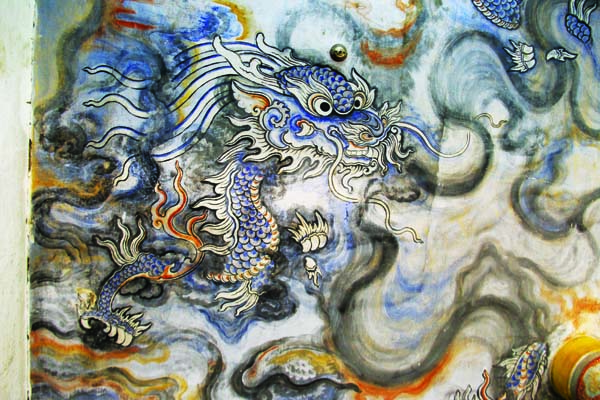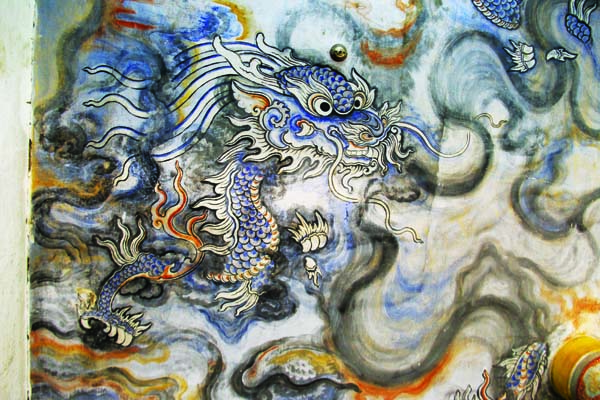(No.5, Vol.8,Oct-Nov Vietnam Heritage Magazine)
Part of the mural Cuu Long An Van in Dieu De Pagoda’s hall ceiling

View of the hall in Dieu De Pagoda, where the ceiling mural is located
As Vatican City has its ceiling mural in the Sistine Chapel, Hue City has Cuu Long An Van, a mural on the ceiling of Dieu De Pagoda’s hall.
Perhaps the Vietnamese masterpiece mural, called in English ‘Nine Dragons Rollick in Clouds’, could not be as magnificent as the mural in Sistine, but it is obvious to some that the painter Phan Van Tanh was at the same talent level as Michelangalo.
Michelangalo lay with his face to the ceiling to paint the Sistine. Tanh did the same, but he held brushes with his feet to complete several sections of the mural.
Included in the royal record is an account that during a visit by Khai Dinh, the second to last king of the Nguyen Dynasty (1802-1945) to the site, Tanh ignored the royal kowtow.
Tanh was the author of the country’s two oldest murals depicting a similar topic, one on the Dieu De Pagoda’s hall ceiling and another on the ceiling of Khai Dinh Mausoleum.
At the time when the king paid his royal visit, Tanh was lying on the scaffolding to paint Buu Hoa Long Van in Khai Dinh Mausoleum. He explained to the king that his ignorance of royal courtesy rules was due to his neglected costume at a construction site as well as his devotion to a royal art work .
The king also considered the artist’s use of his feet to hold a brush during his painting process as disrespectful to the royal work. Tanh replied that the mural was on the ceiling and the painter ought to keep himself far enough to view details of the mural as an audience would. The use of foot was a must, according to Tanh.
The story was covered in several royal documents and those accidentally recorded the second-to-none capacity of Tanh – painting with foot. The story has recently spread again among the country’s art and conservationist community as the mural Cuu Long An Van faces the threat of demolition.
Under a proposed project to restore Dieu De Pagoda, the hall where the masterpiece mural located was scheduled for demolition to make way for new buildings.
The mural includes two sections depicting a legend of the Buddha’s birth. The ceiling mural also depicts five dragons rollicking in clouds. The other four dragons were painted on the pillars reaching up to the ceiling.
The collapse of the hall would mean the mural would be totally destroyed. In late September, researchers, monks at the pagoda, representatives of the local Department of Construction and the Hue Monuments Conservation Centre met for a discussion, but did not reach a conclusion on the preservation of the mural.
At that time, rescuing the mural was hopeless, as the monks wanted the building to be replaced by a newer, bigger one, according to researcher Nguyen Huu Thong.
Hue Monuments Conservation Centre, which is a local government body that manages all relics built by the Nguyen Dynasty in the city and works as a technical advisor for the reconstruction project of the pagoda, said they were waiting for permission from the monks to obtain a digital copy of the mural.
Meanwhile, the head of the Vietnam Institute for Culture and Arts Study in Hue Tran Dinh Hang said the key was that local authorities have not recognised the pagoda as a heritage site, which is a title that helps protect old, historic buildings from development projects and destructive interference. A public campaign called for the protection of the mural broke out soon after the meeting. Local newspapers had their say regarding the possible loss of the mural as well.
Fortunately, the public campaign worked out. A week after the campaign went public, conservationists from HCM City and in Hue succeeded in making the monks change their minds. Monks at the pagoda agreed to restore the hall where the mural is located and will allow the conservationists to restore the mural, as part of it has shown signs of ruin due to leaking from the roof.
According to researcher Nguyen Huu Thong, the land in the front of the pagoda is sufficient for the construction of a new hall, paving the way to the restoration of the old hall at its current site.
‘Keeping the old hall at its original site would change the master plan as well as the structure of the new pagoda, however, it gave the best chance to conserve the most valuable mural in the country,’ he said.
Thong is also calling for the involvement of government agencies in rescuing the mural, because it is part of the country’s cultural legacy.
Phan Van Tanh was a gifted painter in the era of King Khai Dinh (1916-1925). The mural, Cuu Long An Van, is considered the oldest and largest in the country. It is also praised as one of the most significant art works of Vietnamese painting in the 20th century.
Dieu De is the pagoda whose land plot and building structure used to be a private royal residency built for the dynasty’s third king, Thieu Tri. The king was born and had part of his childhood there before he moved into the royal palace.
He later made the residency into a pagoda and other kings designated it a national pagoda of the kingdom.
Cuu Long An Van is one of the key factors making the pagoda a interesting place to visit in the former imperial capital city of Hue.

